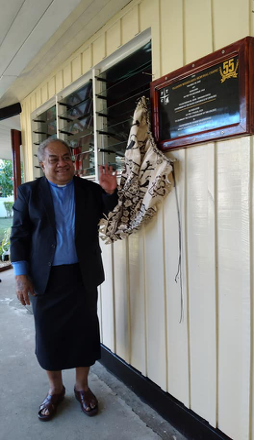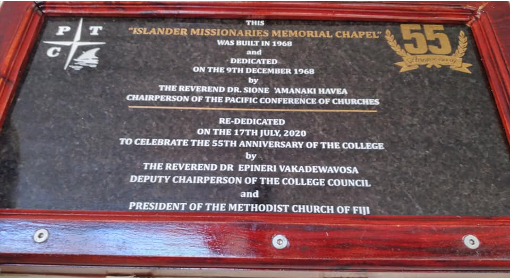By Rev. Professor Dr. Upolu Luma Vaai
On Friday 17 July, the college celebrated the rededication of its chapel, the centre of its life and wellbeing. In the absence of the Chairperson Rev Dr Leatulagi Faalevao due to covid19 restrictions, the Deputy Chairperson Rev Dr Epineri Vakadewavosa did the honour of rededicating the chapel after 52 years of service. The reason for its major renovation was due to the many leaks over the past years that have threatened its structure. To save the current structure and its important history, which has deep meaning to the Pacific ecumenical journey, the management has to act quickly, even under the challenges of the covid19 pandemic. It took the college Maintenance Team six weeks to complete the work.
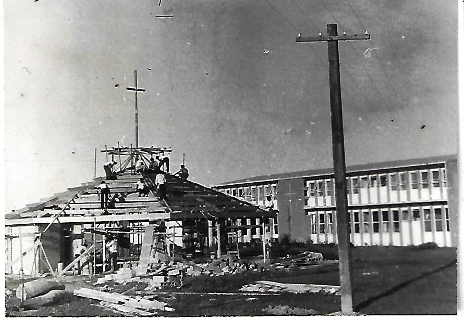
When the chapel was planned for a full renovation, a search for a documented history began. Unfortunately, there was none. So commenced the hunt for information from the PTC library achieves and PCC reports to document one. To our surprise the extracted archival documents shed some light on the historical, ecumenical, and theological significance of this chapel that I believe should be celebrated together with the 55th anniversary of the college this year.
A. Chapel History: A Symbol of Decolonisation
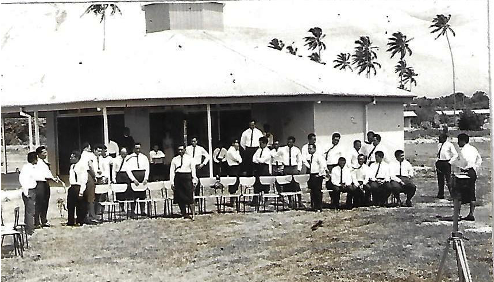
The Islander Missionaries Memorial Chapel, as the chapel was originally named by the Pacific churches, was dedicated on Monday, 9 December 1968, by the Rev. Sione ‘Amanaki Havea, the then Principal of Sia-‘a-Toutai Theological College in Tonga, and the then Chairperson of the Pacific Conference of Churches. As the name of the chapel indicates, it was consciously meant to be part of a larger movement in the Pacific that ardently demanded the rightful place of the Pacific Islanders in their own history which had been at stake during the centuries-long colonialism and its aftermath. It was quite evident in the clarion call given by the first General Secretary of the Pacific Conference of Churches Rev. Vavae Toma from Samoa, in the first General Assembly of PCC held at Lifou, in New Caledonia, in 1966. He said: “while we have carefully preserved the names of the European and American missionaries to the Pacific of last century, we are in danger of losing for all time the names of many more Islander missionaries” (George A. F. Knight. 1968. The Pacific Theological College Newsletter. No.9 (June), 2). As Rev Dr George Knight, the first principal of PTC recollected, Rev Toma stressed on the historical fact that in some cases the Island missionaries “were the first ones to bring the Gospel to the Territories that no white man had reached. Thus both Tahitians and Tongans brought the Gospel to Fiji before the first white man had set foot on its shores” (ibid.).
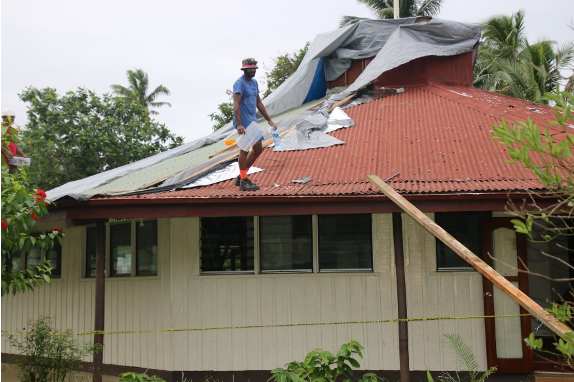
Throughout the Pacific, the islander missionaries built and started theological schools, converted grassroots communities, took the gospel to most remote island communities, the hands, feet, and eyes of the European missionaries on the ground, even led the movements of resilience when the European missionaries were called back to Europe as in the case of the Methodist church in Samoa. Unfortunately most of these sacrificial services were not acknowledged, recognised, or documented by the mainstream Pacific history textbooks that have been written both by Europeans and Pacific islanders. In fact, the current college vision of justice enhances the 1960s church leaders’ vision of justice to the Pacific people’s service and reclaiming their rightful place in the Christian mission narrative. But this narrative should not in any way be intended to underrate the equally heroic sacrificial service of the European missionaries who contributed a lot to the Pacific household even sometimes at the cost of their lives. Rather it is about questioning and overturning a dominant colonial narrative that has contributed to the suppression and non-recognition of similar services offered by indigenous missionaries, or any indigenous peoples. This is why history is critical to changing the narrative. I may say that this chapel, is symbolic of this vision of justice and decolonisation initiated by our forebears.
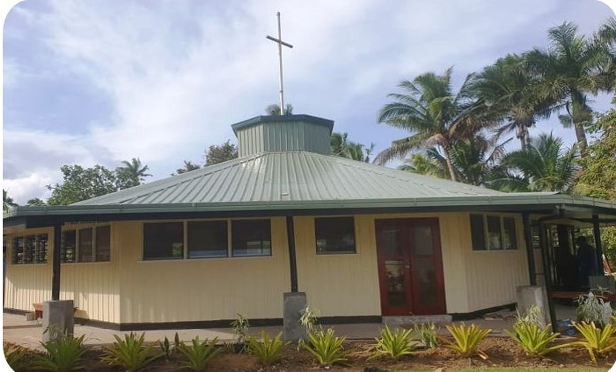
B. Chapel Funding: A Symbol of an Ecumenical Household Commitment
The Report of the First PCC General Assembly in Lifou in 1966 in New Caledonia recorded a proposal of a clear plan for the Chapel to be erected and also a vibrant vision for the chapel. It was recorded in the Assembly report: “We propose to our member churches that a united effort be made by our people to provide funds for the building of the college chapel. We suggest that a special service be held in every village close to 27th June 1967. This would be an act of thanksgiving for the ministry of islanders who have carried the Gospel across the Pacific. A thank-offering made at these services would be sent to the P.T.C. so that the chapel might be a lasting memorial to our own islanders who were such great evangelists…” (The Pacific Conference of Churches. 1966. Report of the First Assembly of the Pacific Conference of Churches held in Lifou, New Caledonia and Loyalty Islands from 25th May to 7th June, 1966: p. 4.). Further, as Dr Knight records that the vision of these church leaders was that “[t]he names of the indigenous missionaries would then be laid up in the Chapel, which would become their memorial…It is gratifying that the names of the Roman Catholic indigenous martyrs and missionaries will be included on the scroll” as well. (Knight, Newsletter, 2). This scroll is in the library though incomplete. Thus this shift of mindsets in the church complements the self-determination and decolonisation spirit of the 1960s in the Pacific. What I can confidently say is that this chapel was meant to be a symbol of relationality not only in community commitment from the ground but also relationality between Catholics and Protestants. We are family in the mission of Christ to the Pacific household of God.
C. Chapel Theology: A Symbol of Decentralisation of Power
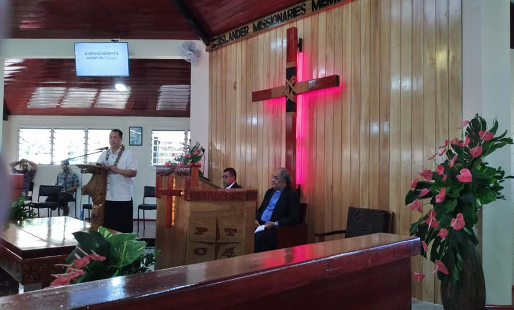
The architecture of the chapel signifies the relational vision of the Pacific churches. The octagonal shape with the pulpit and communion table at the center was designed in such a way that the slide of light from the glass roof at the centre of the chapel would fall on the proclamation of the word and celebration of the Eucharist. This signifies the strong ecumenical spirituality of this place rooted in the philosophy that there are multiple cultures, multiple traditions, and multiple lights that come from different corners of the region and the world that make part of our being. In other words, it was an embodiment of the true ecumenical and relational spirit that the Pacific churches celebrated. The vision is that no one is left out or left behind in this chapel.
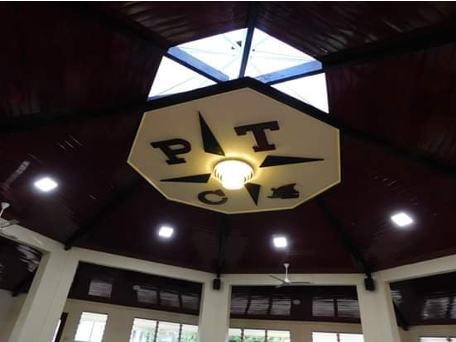
The Pacific churches, having a long-experience of being enslaved by colonisation, wanted to ensure that the new Chapel becomes a symbol of freedom and decentralisation of power. According the Dr Knight, “being virtually circular, the chapel will not sport any seats of the mighty” (ibid). It was envisioned not only that the people who sit in the circular pews enter into a relational face to face encounter with God and with each other, but also should redeem themselves from the single-might to embrace multiple lights, from one dimensional to multi-dimensional faith, and from being individualistic to embrace a neighborly spirit during worship. Hence the chapel as the great equalizer symbolises that all are equals when we come to the presence of God (Knight, Newsletter, 2).
CONCLUSION: THE POWERHOUSE

To conclude, the powerful symbolism of this chapel provides vision and hope of why this space should be at the heart of our ecumenical journey. This space is not just a chapel. It is a compass of decolonisation. It powers both the college spiritual journey and the ability to be able to see and interpret life from different multiple perspectives, especially from the perspective of those suppressed by colonial conventional ways. Our forebears had vision that this chapel could ignite and shape a movement to change our mindsets for a new story for the Pacific household of God. This is the initial step into redemption. Into our metanoia moment. Into recognising and giving credit and respect to those who deserve it. Like the islander missionaries. Like those who own this land the college is built on?the Suvavou people. I do hope that what comes out of this chapel, its liturgy, its biblical and theological reflections would continue this vision of decolonisation, ecumenical commitment, and the decentralisation of theology, structures, and leadership in order to be faithful to the gospel of Jesus Christ.
Acknowledgement:
I acknowledge God for allowing us this space under the extraordinary pressures of the pandemic to complete this work. To Tui Suva and the Vanua o Suva for allowing the college to exist on their land. To the Chairperson, Deputy Chairperson, and members of the College Council for their prayers and support. To our mission partners for always believing in a partnership in mission. To the PTC community for their endless support. Last but not the least to the Construction and Maintenance Manager and his Maintenance Team that made this possible. Vinaka!
Announcements to PTC community:
- The chapel will be opened from 8am to 4pm, Monday to Friday, to host community prayers, meditations, and quiet time for individuals and families for the PTC community and the wider Suva ecumenical family. The college chaplain will be responsible for this initiative.
- From next year 2021, because of the chapel’s important history and theology, the college will honour the churches’ vision by celebrating annually the 27thJune as the memorial day to remember the sacrifices of the islander missionaries to the Pacific household. By celebrating every year their contribution to Pacific Christianity, we celebrate as well the meaning and purpose of this chapel.
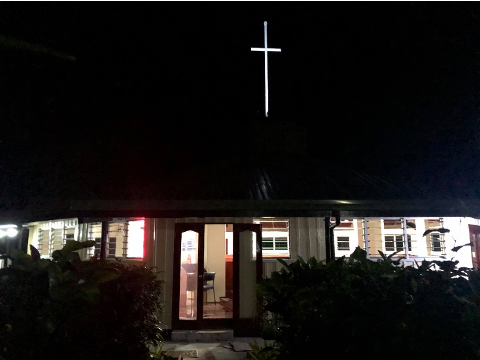
Vinaka vakalevu!
Principal
20 July 2020

